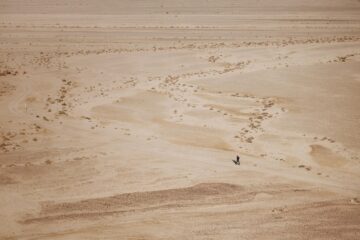Just when you become reconciled to the fact that fond memories of the past will remain in the past, you get a reprieve. When I was an active duty soldier, I had the opportunity to take my unit to the massive National Training Center (NTC) at Fort Irwin, California located 37 miles northeast of Barstow in the Calico Mountains. It’s the premier training facility where Army units are put through their paces to evaluate their combat readiness.
The NTC is over 1000 square miles of high desert with temperatures that range from 100 degrees in the summer to sub-zero in the coldest periods of the winter. In this environment, soldiers must be prepared for harsh conditions, made more so by the NTC’s world class opposition force—known as the OPFOR—with whom units must test their metal.
I recall my experience there with the 1st Infantry Division in 1989 and 1990 and wrote about it in my book Desert Redleg: Artillery Warfare in the First Gulf War. The NTC helped many units prepare for that war without knowing such a conflict would actually occur. But it did occur within months of our last visit to the NTC in the fall of 1989. Despite the hard lessons we learned—those successful and many others not so much—we nonetheless improved. We took those lessons home with us and applied them to our training on the plains of Fort Riley, Kansas. We hoped to improve the next time we met the OPFOR, who mimicked quite well the tactics of the former Soviet Union. We had no expectation that “next” would not be in the high desert of California, but the expansive foreign deserts of Saudi Arabia, Iraq, and Kuwait. There the “OPFOR” really did want to kill us.
Indeed, we would not fight Russians, but rather their surrogates in the Middle East, Saddam Hussein’s Iraqi Army. As a result of the taxing training at the NTC, we dealt the Iraqis a decisive defeat in the winter and spring of 1991. That was then. Today the NTC is learning and adapting quickly from the war in Ukraine and applying revised tactics to test the US Army for future combat that will be more challenging than anything we’ve seen in the past.
Since I am currently authoring a book on the role of the artillery in future wars, I have wondered how the NTC is preparing today’s Army units for that inevitability. But at 73, I had little hope that I would have a change to see that training as it is today. Imagination would have to suffice.
But then this happened. I was invited to Fort Riley last month to address the annual Artillery Ball honoring Saint Barbara, the patron of the artillery. In my address, I focused on future war and the need for young artilleryman today to engage in a renaissance of sorts to prepare the artillery for the major challenges it will face in the future. It was well received. That was good. But imagine my surprise when the 1st Infantry Division Commander approached me and extended an invitation to travel to the NTC this month to observe the artillery and the division interact in operational planning.
Ever wonder what it feels like to be a boy on Christmas morning opening a coveted present? That was how I felt. So next week I’ll travel to my old haunt, the NTC, to observe young artillerymen who were not alive when I first confronted the challenges of the high desert.
This will truly be a wonderful opportunity for me to gather research on what the artillery must do to transform and prepare itself for future wars. Much has changed since I retired in 2001, but the fundamentals are the same, even though the role of technology and the innovations we’ve witnessed in the Ukraine war must be contemplated as we prepare for future conflicts.
On this particular trip, I want to observe this new generation of artillerymen conduct the planning they will need to do to defeat today’s world-class OPFOR. What will they do to build feasible and executable plans? What will be involved in that? How will they factor the plethora of data they must consider from a host of sensors and other intelligence sources that at times can be overwhelming? What systems and technologies do they have to do all of that? More importantly, what do they lack that they need in order to overcome the obstacles that they will face on future battlefields?
So many questions. And I will have the privilege of observing modern artillerymen as they sort out what must be done to log future victories.
Sometimes, life serves up unexpected opportunities, and to be sure, this aging artilleryman has secured an unexpected one. I’m exhilarated.



0 Comments